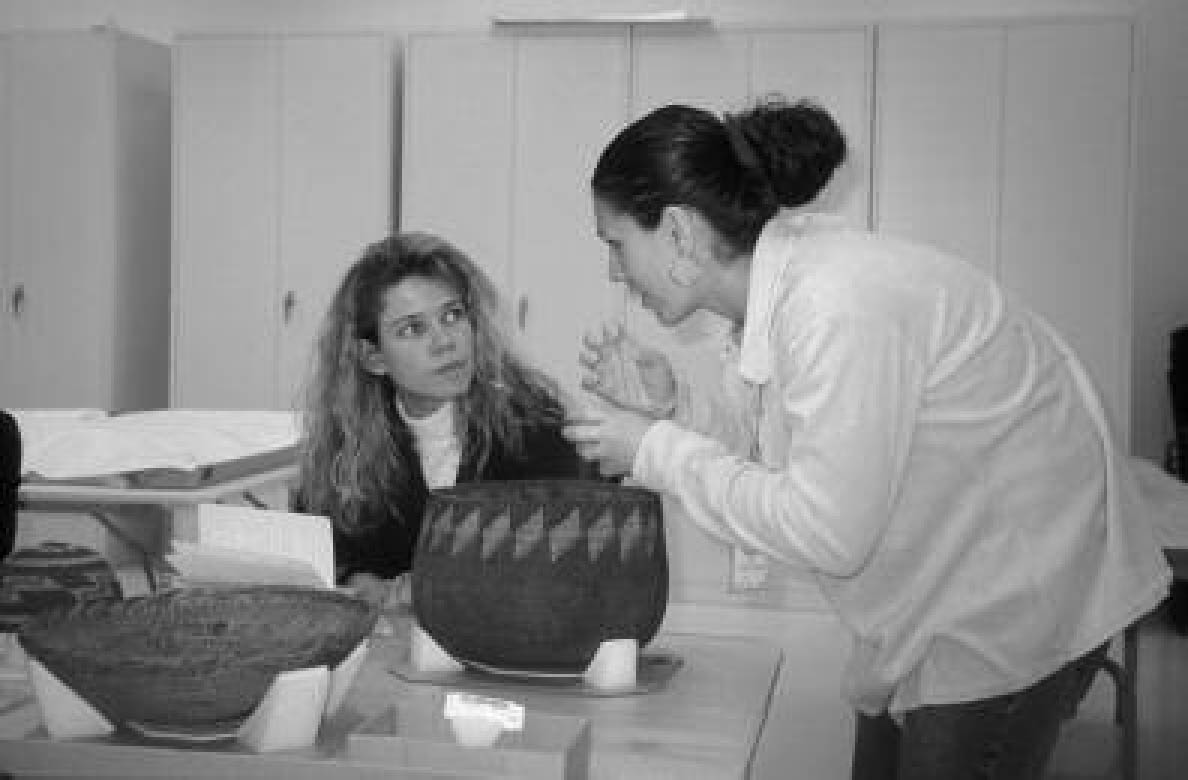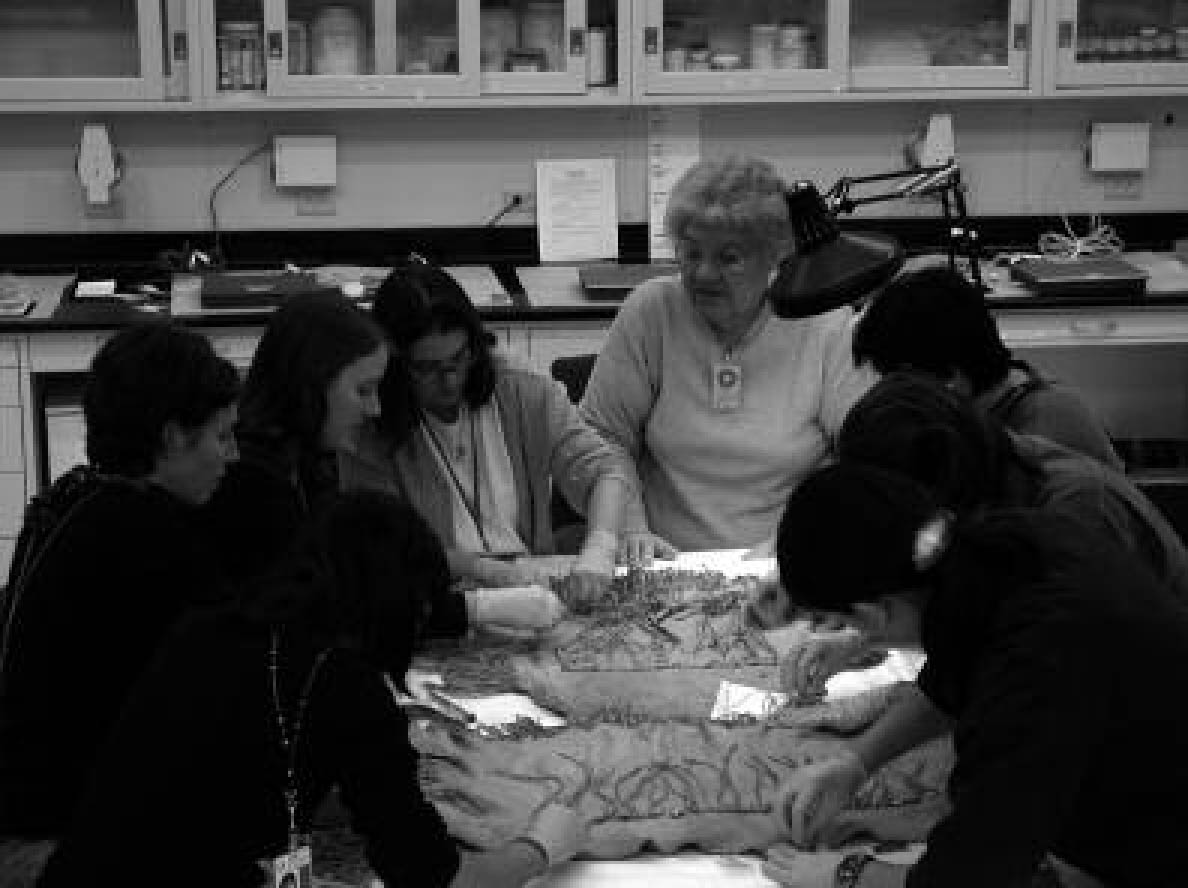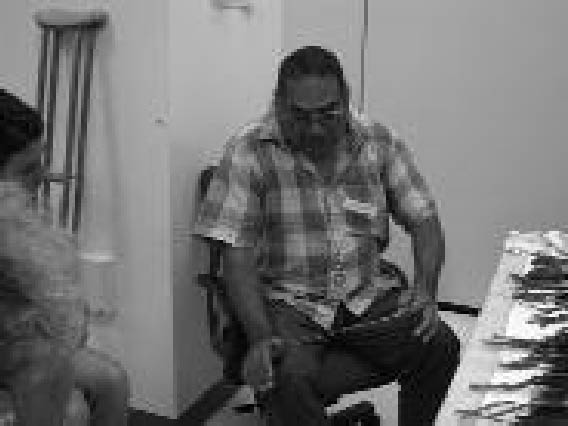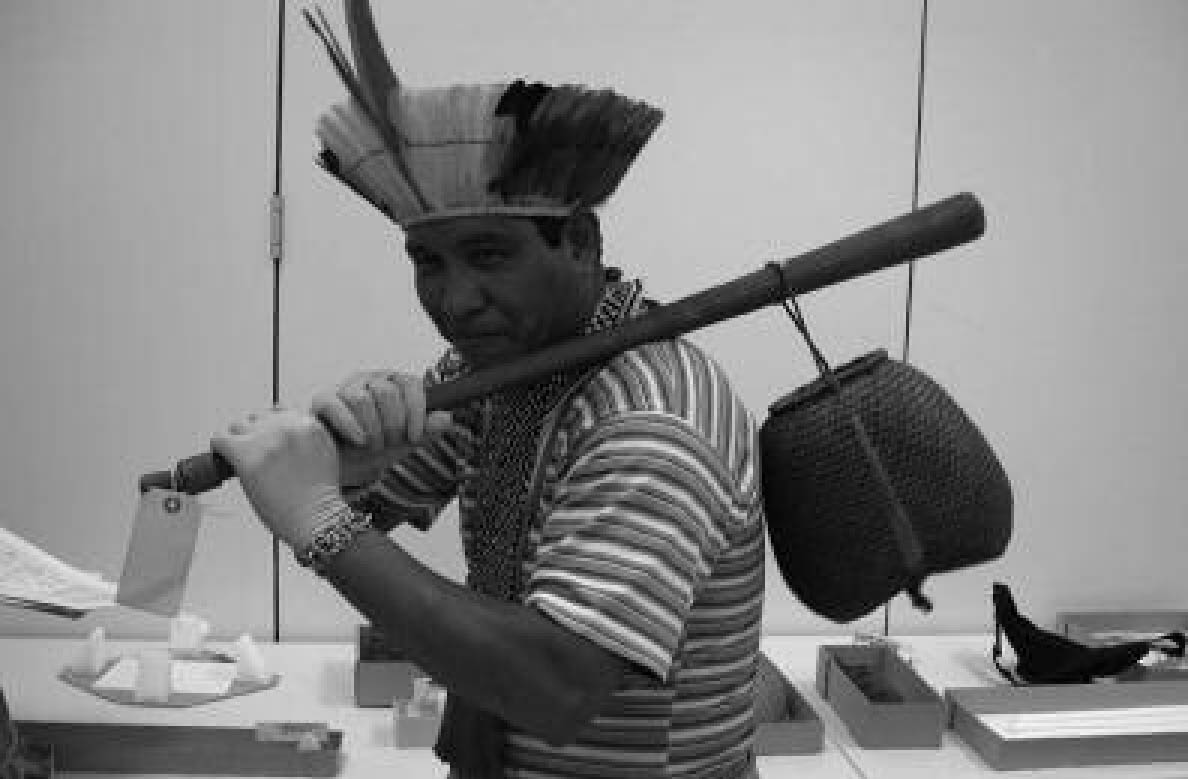PRACTICAL ASPECTS OF CONSULTATION WITH COMMUNITIESJESSICA S. JOHNSON, SUSAN HEALD, KELLY MCHUGH, ELIZABETH BROWN, & MARIAN KAMINITZ
3 CONSERVATION CONSULTATIONS FOR THE MUSEUM ON THE NATIONAL MALLThe conservation consultation was an integral piece of the bigger exhibition development project. Conservators worked very closely with curators who had previously established a working partnership with members of the Native communities who collaborated with the museum on exhibits. Each exhibit is developed by working with community curators who were either identified by the tribal government, or identified as religious knowledge holders, depending on the topic of the exhibit. The conservation consultation process is a natural extension and outgrowth of these relationships. Curators at the NMAI contacted Native community curators with whom they had already been working and asked them to recommend community members who would be appropriate for the conservation consultations. Often the Native conservation consultants were artisans such as mask makers, beadworkers, or quillworkers, but sometimes they were elders, tribal leaders, or a community curator. In most cases, the NMAI curator made the initial phone or email contact to potential conservation consultants for specific projects. The NMAI conservator overseeing the project then contacted the consultant and, in the course of making arrangements for consultation meetings, began to establish a relationship with the consulting Native individuals. Usually two or three people were invited from a community. Each conservation consultant was paid a standard honorarium and all travel expenses were paid. Consultants were asked to sign a waiver form allowing NMAI to use the information that they provided for the development of the Mall exhibits. Any other use of this information requires a separate agreement with the consultant. 3.1 AWARENESS, SENSITIVITY AND COMMUNICATIONThe overall premise behind the consultations is to develop a level of comfort and trust to facilitate the sharing of information. At NMAI the following items were found to be useful to keep in mind during the visit:
Effective communication is very important in the consultations. As with any human interaction there are layers of history, experience, and personality that go into a discussion filled as much with non-verbal communication as with words. Setting aside two to three days for the consultation allows everyone to become more comfortable and facilitates the exchange of information. It also allows individuals time to think things over and revisit questions and decisions if necessary. Many of the post-consultation, internal lab discussions have centered on how the conservators understand all the layers of interaction and how personal interpretations affect the ability to communicate. Coinciding with the museum's mission, the individual curators and conservators involved in these exhibits felt that they fully support Native peoples. However, the conservators are also representatives of the Smithsonian Institution, which has a long and troubled history with Native peoples. All the conservators live and work in the Washington, DC area, center of the United States federal government, which is viewed with distrust by some Native people. Most of the conservators who worked on this project are women. This created some difficulties as some communities have traditional knowledge and care requirements that can only be shared with or carried out by individuals of the same gender. Out of nineteen conservators who worked on the Mall projects only three preprogram interns were Native. Identifying these differences and similarities and being aware that they may affect the consultants' interactions with conservation staff (despite NMAI staff members' good intentions) is important. Rose (1988) observed that conservation training in the United States was rooted in a Eurocentric aesthetics-based tradition that did not consider or emphasize the cultural use or importance of an object. However, despite changes in the conservation training programs that have sought to address this imbalance, each conservator found that his or her conservation training did not prepare us for the interaction. Initially, the NMAI curators (both Native individuals and non-Native anthropologists who had experience interacting with Native communities) were relied upon heavily for guidance in appropriate behavior. Eventually, successes and mistakes taught each conservator a great deal. One of the most helpful concepts the conservators learned from NMAI curators as well as from experiences on this project is that individuals must be aware of how they listen (fig. 3). NMAI participants have learned to say very little in the beginning of the consultation, when objects are first being discussed, in order to reinforce that the power to make decisions about their cultural material in the Museum resides with the consultants. Most importantly, individuals have learned to be flexible; consultations have had a loose structure with room for variability depending on the personalities involved. For example, Juan Antonio Panecura, a Mapuche consultant who teaches Mapuche culture, structured the consultation like a lecture; whereas a Kiowa consultant, Marcie Davilla, who makes traditional hide dresses, led an impromptu workshop on cleaning hide (fig. 4). Furthermore, conservators learned to allow Native consultants to handle objects as they wished, as these artifacts are very personal components of their lives with value beyond their physical condition. In the course of consulting about specific treatments, questions arose that needed to be posed in such a way as to elicit detailed thoughts from the consultant regarding the way their community would want the object to appear. “Yes” and “No” questions were constricting and not useful, and specialized professional vocabulary (such as treat, consolidate, and adhere) generally had little meaning to non-conservators. The conservators' modes of questioning in the beginning resulted in some answers that were difficult
One of the greatest difficulties throughout the developing consultation program has been for each conservator to find his or her own comfort level in communicating with Native consultants, and accepting and carrying out treatments that are outside of the Eurocentric experience. Careful and sensitive consideration is required when a consultant asks the conservators to do something that is outside of regular conservation methodology or uses unconventional materials. Occasionally, the consultants recommend a cleaning method or material that, from the perspective of a western-trained conservator, is believed to cause damage in the long term. In other instances, the consultants have requested restorations that NMAI conservators were not prepared to carry out. In the case of controversial cleaning methods or materials, the NMAI conservators continue discussions to ascertain whether the material used to do the cleaning or consolidating is important, or if it is the appearance or effect of the material that is important. If the latter, the conservators suggest materials that can be used to achieve the same visual effects and discuss the relative merits of this approach with the consultants. When the NMAI conservators felt they lacked the skills required to carry out the restorations to the extent requested by the consultant, consultants have been asked to carry out the treatments. One example, a project with Lakota consultants, is discussed in detail below. All these treatments were carefully documented and include a description of how the treatment choices relate to the consultation as well as a rationale for carrying out the treatment. 3.2 COLLABORATION WITH LAKOTA CONSULTANTSDuring their conservation consultation, Lakota consultants Cecilia Fire Thunder, Fedelia Cross, and Matilda Montileaux expressed their desire to improve the appearance of a water-damaged beaded pipe bag by removing discolored, stiff fringe and replacing it with new brain-tanned fringe (fig. 5). They wanted it to look its best on exhibit because it is a reflection of their culture. Through the discussions at the consultation it became clear that the best way for the bag to be repaired was through a second collaboration visit between the Lakota women (who know the importance of a pipe bag from the Lakota cultural perspective as well as understanding the technology) and NMAI conservators (who would provide materials, carry out some processes, and document the project). Before the second visit from the Lakota consultants, conservator Elizabeth Brown prepared the bag through photographic and written documentation, cleaning the surface with a soft brush and vacuum, humidification and flattening of fringe at the upper edge of the bag, and stabilizing loose quill wrappings with Tyvek bridges and Acryloid B-72 in acetone. On their return, the consultants first tested the original water-damaged fringe using scrapers to break up stiffened collagen fibers and a soot removal sponge to clean the surface. When the results proved to be unsatisfactory because the fringe was too damaged and weak, there was further consultation between the consultants, the NMAI Curator Emil Her Many Horses (who is also Lakota), and NMAI conservators to decide on the details of the fringe removal and replacement. The treatment was done with Fire Thunder, Her Many Horses, and Brown working together and doing practical work according to their own expertise. The old fringe was cut off close to its attachment through the ends of the upper quill wrapped strips and placed into storage with the NMAI treatment records. Local humidification of the area was then used to soften the rawhide so the fringe remnants could be pulled from the holes with tweezers. New fringe was cut from a piece of brain-tanned deerskin provided by Emil Her Many Horses. To strengthen the area around the puncture holes at the end of the rawhide strips, a heavy-weight Reemay toned with acrylic paint was used to face and back the holes. The new fringe strips were then pulled through the original puncture holes. In order to more thoroughly clean the bag, white corn meal was rubbed into the exterior of the bag by hand and then the surface was scraped with the edge of a micro-spatula. This pulled out embedded dirt and appeared to resoften the collagen fibers. Excess corn meal was removed by vacuuming. Next, dry pigments were used to tone the fringe to make it visually similar to the rest of the hide on the bag and the fringe was cut to an appropriate length. Quillwork was cleaned with deionized water to remove flyspecks and grime. The whole process was This project was one of the most in-depth and extensive collaborations that took place during the preparation for the Mall exhibits; however, all the consultations provided information and practical details that led to desired changes in the objects that reflected the wishes of the community. Joint efforts, like the work on the Lakota pipe bag, help develop deeper museum/community partnerships. Consultants and conservators often share a common interest in the materials and techniques used to make the items they are examining. Consultants were generous in sharing their knowledge on topics such as weaving techniques, dying, carving, silversmithing, or how to make rolled fringe (fig. 6). These consultations presented rare opportunities for NMAI conservators and curators to understand firsthand some of the technologies and philosophies that engendered the objects in the collection. 3.3 DOCUMENTATIONDocumentation of the conservation process, including the consultations with community representatives, is integral to NMAI's procedures (Chang and Heald 2005). Various documentation techniques contribute to the record of each project. First, every consultation is audiotaped. After the consultants have departed, the information is compiled into three-ring binders with notes, digital images, and background material such as maps, bibliographies, and information about the exhibition concepts. Conservators who did not directly participate in the consultations are also involved in the treatment of the objects, so these binders are vital to ensuring the treatments follow the consultants' wishes. The audiotapes are also reviewed to clarify gaps in the notes, and tape indexes are created. Conservators have found it useful to return to the original tapes as small nuances and subtleties can be lost in rapid note-taking. The images taken during the consultation are also extremely
Occasionally treatment questions have arisen after the consultants have left. For some of these cases, documented information obtained from similar objects was used to gain a sense of the group's approach to repair or cleaning. Some issues were also resolved through discussions with the NMAI staff who participated in the original consultation. In a few instances where the appropriate treatment was still not clear, the community representatives were contacted for clarification or additional information. While the process of consulting with Native community representatives may seem very time-consuming, in fact it often saves time during the treatment phase. Much less time is spent studying the literature for the essential cultural and material identities of specific objects. In many cases, consultants have asked us not to perform treatment that conservators would routinely do otherwise, such as filling cracks, cleaning, or repairing tears. In a few cases, the consultants have requested that the conservators refrain from treating certain objects at all because the conservators are not members of the culture that produced them. At the end of the consultation each consultant is given a commemorative gift as well as a packet of
By maintaining partnerships with the consultants, the NMAI conservators hope to ensure that the source communities maintain an active and guiding voice in the care of their objects in the Museum's collection in the future. |




